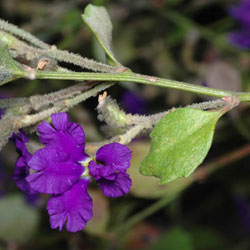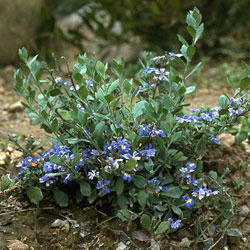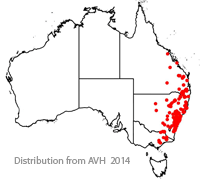Dampiera purpurea
 |
 |
Mountain Dampiera, Purple Dampiera
Dampiera purpurea R.Br.
 Endemic to Australia, Dampiera purpurea belongs to the Goodeniaceae family and is distributed along the south-eastern coast of Australia from Queensland to New South Wales and Victoria. It is widespread and is quite common in the wild. It is commonly known as the Mountain or Purple Dampiera.
Endemic to Australia, Dampiera purpurea belongs to the Goodeniaceae family and is distributed along the south-eastern coast of Australia from Queensland to New South Wales and Victoria. It is widespread and is quite common in the wild. It is commonly known as the Mountain or Purple Dampiera.
Dampiera purpurea is a small perennial suckering herb that reaches 1 to 1.5 metres high and can spread to 2 metres across. It has erect angular woody stems that are sparsely branched and densely hairy. Leaves are 1–6 cm long, 0.5–2.5 cm wide, densely hairy above and slightly hairy below. These can be lanceolate to orbicular, and toothed or entire.
Flowers are 2.5 cm across, pale purple to dark purple with a light yellow centre, and the exterior has dense dark grey hairs. They can be axillary or terminal, either solitary or in loose, short racemes. Dampiera purpurea flowers from September to December and produces fruits and seed from December to March.
The species inhabits open eucalypt woodland. It is quite hardy, able to grow under a wide range of conditions. However it grows best in sandy soils where it suckers freely. It prefers low humidity, is frost tolerant and will grow in spotted shade to full sun. It prefers free-draining soil, and does require a small amount of watering when propagated. Honeybees and butterflies have been known to visit the flowers and are thought to pollinate the plant.
It propagates from cuttings (young suckering growth strikes readily) or by division. It is tricky to propagate from seed; however, once established it grows quite easily and requires no maintenance including pruning or fertiliser.
Dampiera purpurea responds to fire; when the stems are burnt the plant re-sprouts from the base. Plants have been known to flower 10 months after fire.
Text by Holly Price (2014 Student Botanical Intern)
Name meaning: Dampiera purpureaDampiera – after William Dampier (1652-1715), a buccaneer who collected some Australian plants. Dampier's specimens are preserved in the Fielding-Druce Herbarium (OXF) at Oxford University, UK. purpurea – from the Latin for purple |
References:
Australian Native Plant Society (Australia) (2007), Dampiera purpurea. Available at http://anpsa.org.au/d-pur.html [Accessed Feb 2014]
Benson, D. and McDougall, L. (1997), Ecology of Sydney Plant Species, Cunninghamia 5(2): 331–554 .
Elliot, W. R. & Jones, D. L. (1984),
Hurle, P. (2014), ANBG Horticulturalist, pers. comm.Encyclopaedia of Australian Plants Suitable for Cultivation Vol 3, Lothian Publishing Company, Melbourne Marges, D. (2014), ANBG Horticulturalist, pers. comm.
![An Australian Government Initiative [logo]](/images/austgovt_brown_90px.gif)

